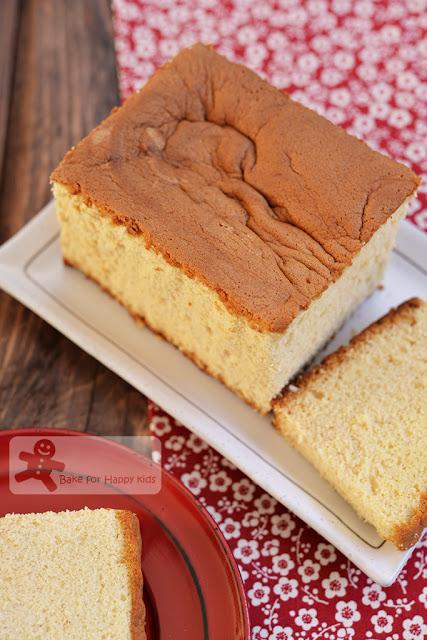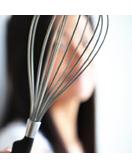Until today, I'm still the crazy Castella cake baking woman and my Castella cake baking is still never-ending! Then, why I have not publish my next Castella cake post for a while???
All because the fussy me have not found the next Castella cake recipe that is worth mentioning yet.
Why??? For my fifth Castella cake episode, I'm trying to answer another question...
Does the addition of more eggs or egg yolks make a better Castella cake? To answer this question, I have gone really really really CRAZY baking numerous Castella cakes!!! Siao liao ah!!! - meaning already gone crazy in Singlish-Hokkien language. LOL!
Based on all, this is the most chewy bouncy Castella cake that I have baked so far...
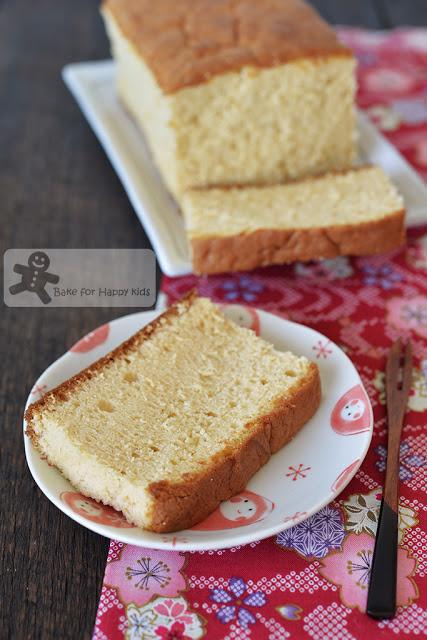
Japanese Castella Cake / Kasutera カステラ - with extra egg yolks
Why more eggs or egg yolks in Castella cakes???
I started off by baking a recipe that is modified from Cookpad that contains one more egg than other Castella cake recipes that I have baked before at here, here, here, here. Due to the extra egg added, the proportion of flour to egg in this cake is lesser than most Castella cakes. Thus, resulting the cake to rise higher with a small crack and shrink very badly when it is completely cooled.
Despite its ugly crinkled look, I tasted the cake and was surprised that the one-extra-added-egg is actually moister and bouncier!!! However, after weighing the pros and cons of this cake, I still think that the extra egg added is not necessary!
Lesson learnt: The total weight of the eggs required to bake a typical 10 x 20 cm Castella loaf should be exactly 160g and should not be any more or less or the proportion of flour to egg should be not less than 0.7.
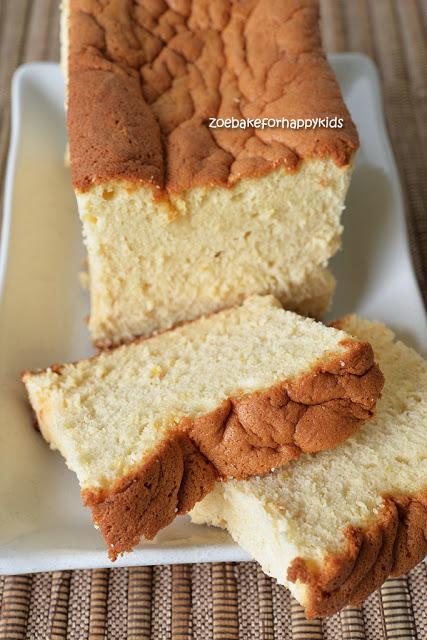
Japanese Castella Cake with extra one egg
Ugly and crinkled but moister and bouncier!
Seeing the difference in taste and texture with one extra egg, then I wonder...
Does the addition of more egg yolks make a better Castella cake?
To answer my question, I have modified my best Castella cake recipe with two extra egg yolk by replacing the amount with less egg whites so that the total weight of the eggs used in my typical 20 cm Castella loaf can be remained at 160g. Interestingly, I have yielded a moister and better tasting cake with thicker golden brown top and bottom cake crusts. Yum! Yum! ... but sadly, it shrinks very badly when it is completely cooled and also cause the cake to be too dense at its bottom.
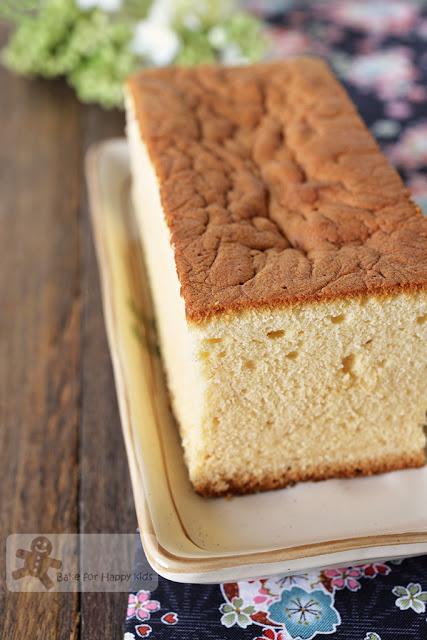
Japanese Castella Cake with extra egg yolks
yummy with thicker golden brown top and bottom cake crusts
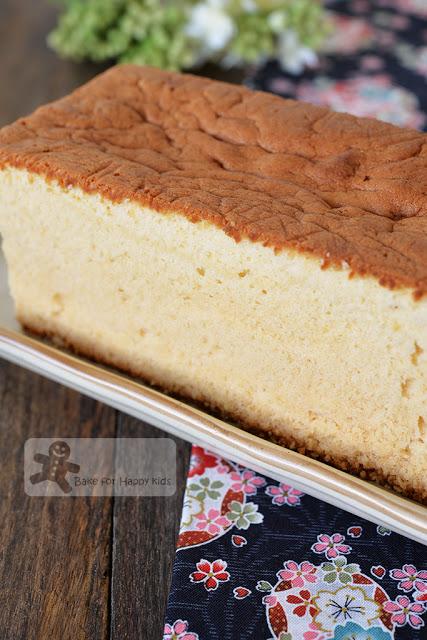
... but its bottom is too dense!
I'm not giving up...
Next, I have modified and baked this no oil Castella cake recipe with one extra egg yolk and replaced the amount with less egg whites in order to keep the total weight of the eggs in my typical 20 cm Castella loaf to be 160g. Sadly, it is not perfect too as it shrinks and sink in its middle when it is completely cooled. sob sob...

Japanese Castella Cake with extra egg yolks
Despite its imperfect sink-in-the-middle look, the cake with extra egg yolk tastes pretty good!
It is actually moister and tastier than the original perfect looking one that I baked at here!!!
Look vs taste? Hmmm...
Last but not the least!!!
As I searched further, I found a good Castella cake recipe with extra yolks at It's My Dish. YAY!!! Yes that the total weight of the eggs in this typical 10 x 20 cm Castella loaf is 165g and the proportion of flour to egg is 0.7!!!
Due to my preference to use egg separation method to bake Castella cakes, I have modified the recipe and managed to bake this extra chewy Castella cake. It is extra yummy with its extra thicker golden brown top and bottom cake crusts! Yum! Yum!
Wait wait... I have to mention that the cake will shrink but very minimally and the good thing is it won't sink in the middle. If you compare the following photo with the ones above it, you will see the differences and also what I meant...
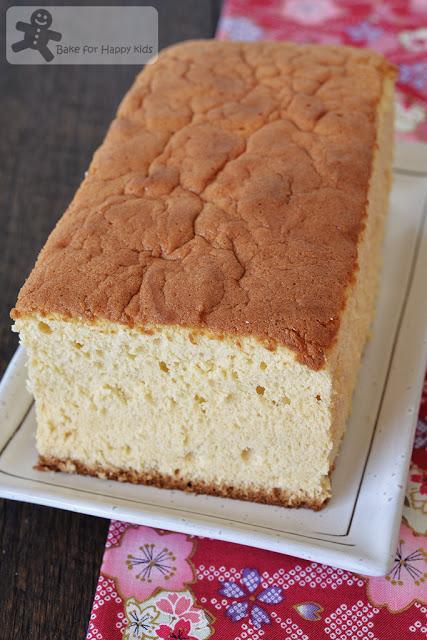
Finally... this is the chewy Castella cake recipe with extra egg yolks that works the best!
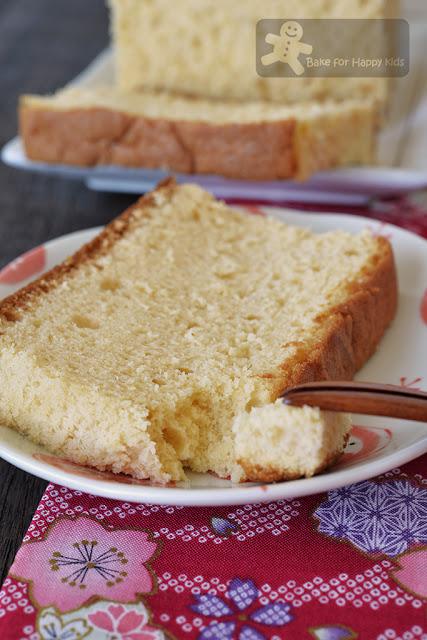
Extra chewy! Extra thick golden brown top and bottom cake crusts! Extra yum yum!
Am I happy to conclude my fifth Castella cake episode? Sort of. I can't be too fussy with these cakes or else I will be a joke for going mental because of Castella cakes!!! LOL!
Does the addition of extra egg yolks make a better Castella cake? YES!!! Based on the Castella cakes with extra yolks that I have baked, I must say that they are actually tastier with bouncier texture plus thicker top and bottom cake crusts.
However, I have to emphsize that these cakes will shrink after cooling and this is the recipe that makes the most chewy Castella cake that will shrink the least so far!
Here's my one-minute video showing how I baked this extra yummy extra egg yolk Castella cake.
Here's the recipe.
Make one 17.5 x 10.5 x 8 cm or 10 x 20 x 8 cm Castella cakePlease weigh all ingredients and use the exact weight.
For the egg yolk mixture:40g (about 2 tbsp) honey
30g (2 tbsp) milk
60g egg yolks (about 4 egg yolks), at room temperature
50g caster sugar
115g bread flour with about 12% protein
For the egg white mixture:
105g egg whites (about 3 egg whites), at room temperature
50g caster sugar
Place a baking rack in the middle of the oven. Preheat oven to 160°C / 325°F with NO fan forced.
Line the internal sides of your cake or loaf pan with aluminum foil and a piece of baking paper to fit its bottom. Sprinkle the bottom of the lined pan with pearl sugar if desired and this step is optional. If you are using 10 x 20 cm standard loaf metal pan, please see here for instructions and photos to prepare your metal loaf pan for your Castella cake baking.
For the egg yolk mixture:
Place honey and milk in a saucepan or heat proof bowl. Cook mixture in the saucepan using the stove with low heat or microwave mixture in the heat proof bowl with short pulses of low power until the honey dissolves into the mixture and becomes runny. Do not over-cook the mixture until it boils. Set aside for the mixture to cool slightly, about 10 mins.
Place egg yolks and sugar in a large mixing bowl and use a hand whisk to beat until mixture turns lighter in color. Whisk in the honey mixture. Sift flour into egg yolk mixture and whisk until everything is combined. NOTE: This mixture will be thick and sticky.
For the egg white mixture:
Using an electric mixer with a whisk attachment, beat egg whites in low speed until foamy. Increase beating speed to medium low (not too high to avoid large bubbles forming). While beating, add sugar gradually. Increase beating speed to the next higer speed (medium) and continue to beat until stiff peaks form and the meringue look smooth and glossy. Do not over beat the mixture.
To combine and bake:
Using a hand whisk or a spatula, fold in the egg whites to the egg yolks mixture in 3 portions. It's ok to mix the first batch of egg white mixture kind of vigorously into the egg yolk mixture but please ensure that the subsequent batches are mixed in very gently until most of the white is not visible after folding.
Pour batter into the prepared pan. Gently drop the pan onto the kitchen bench from a height of 10 cm to remove any large air bubbles and do this just once. If you are afraid of doing this, you can use a skewer to draw a zigzag to remove air bubbles in the batter. You can choose to do either one of these steps or both but do not over-do these steps.
Place pan in the middle rack and bake for 10 mins. Decrease temperature to 150°C / 300°F and bake for another 40 mins, or until the cake is thoroughly cooked and must has a nice golden brown top. NOTE: (1) An inserted skewer or cake tester is not a good gauge to see if the cake is thoroughly cooked. (2) Different oven is different. To optimize your baking, you might wish to try other oven temperature setting that I have mentioned earlier in this post.
IMPORTANT: This cake will shrink! To minimize the cake from shrinking, drop cake from a height of 30 cm immediately when it is removed from the oven. Then, allow cake to cool slightly until it is cooled enough to touch. Remove the cake out of the pan, peel off the foil and the baking paper at its bottom and wrap the cake in plastic wrap. Place the wrapped cake in an airtight container or a zip lock bag and allow it to rest in room temperature so that the cake will moisten by itself for at least one day.
Slice and serve on the next day. Store the uneaten cake in airtight container for up to 3 days in room temperature.
Happy BakingPlease support me and like me at Facebook...
